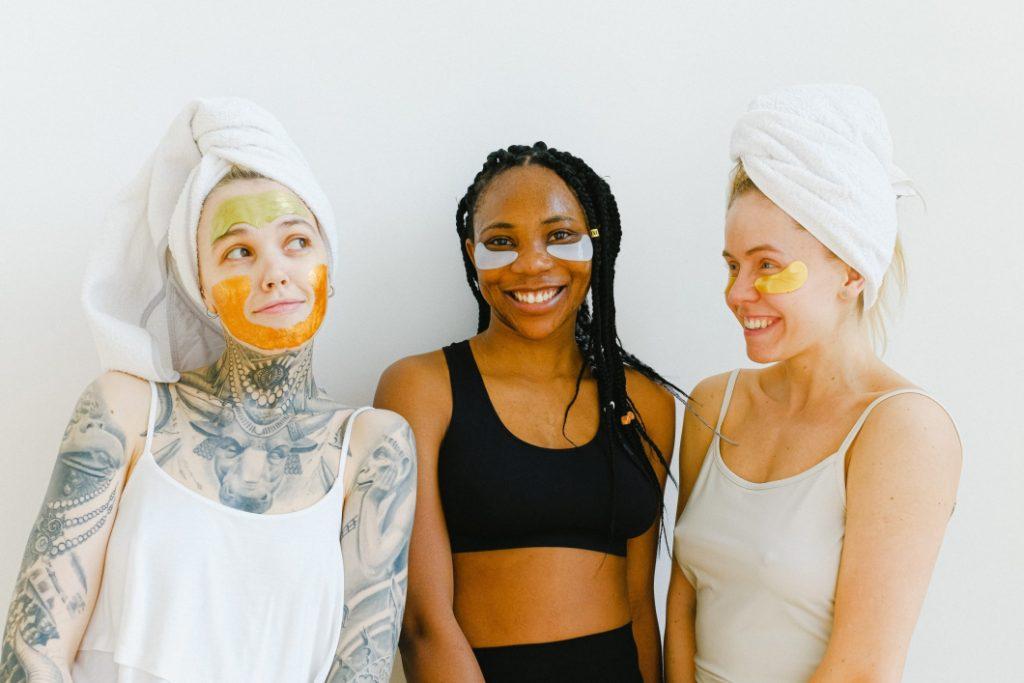Note: This is a follow-up to my Skincare For Beginners post. If you’re brand new to building a skincare regimen, start there!
So you have a great basic skincare routine. You cleanse and moisturize (just about) every morning and (pretty much) every evening, and you even use sun protection on a regular basis. You’re ready to take the next step and add a little novelty to your routine. You have had enough practice splashing your face like a starlet in a 90s Clearasil commercial to know now that it will never not make a mess, and it’s time to try gingerly patting fancy potions into your skin like you’re in a Vogue Beauty Secrets video. (No? Just me? If you say so!) It’s time to add the next big three to the routine:
Serums, exfoliants, and retinoids.
This part of skincare can easily get very overwhelming (not to mention very expensive). Have no fear. In my experience, it’s easiest to focus on specific ingredients, and look for products accordingly. If I’m going to spend over $60 on a 1 ounce bottle of serum from a luxury brand, it better be a magic eternal youth elixir that will not only erase my fine lines but literally make me 17 years old again. Until they can make that happen, I prefer using skincare brands that have popped up in recent years that focus on affordable, single-ingredient products. The Ordinary, The Inkey List, and Good Molecules are all great brands that make simple, easy to understand skincare products that won’t break the bank. Plus, they’re all cruelty-free, which is always a nice bonus!
Let’s talk ingredients.
There is no rule that says you need to have every single one of these in your routine, and this is by no means an exhaustive list, but these are the things I like to look for.
- Hyaluronic Acid – When you’re looking to boost your skin’s moisture, hyaluronic acid is the place to start. At $6-$8 a bottle from the aforementioned skincare brands (and Trader Joe’s, too!), a hyaluronic acid serum is affordable, easy to use, and unlikely to cause irritation, making it the perfect choice for baby’s first serum. (In this instance, you are baby.) As an ingredient in a moisturizer, a toner, a cleanser, as a base for a serum, or a serum all on its own, hyaluronic acid works by helping your skin to retain water, and by now we all know that moist skin is plump, smooth, soft, happy skin. Despite having “acid” in its name, it is gentle and kind and gets along well with all of the other skincare ingredients. On its own, it works best on damp skin, so a hyaluronic acid serum is best used as the first step of your routine after cleansing, before other serums.
- Peptides – Peptides are for anti-aging. They’re supposed to reduce the appearance of existing fine lines and wrinkles, while encouraging collagen production and firming the skin enough to prevent new wrinkles from forming. For the most part on their own, peptide ingredients are pretty gentle and get along well with most other ingredients, but always check instructions for any contraindications. If you want to work peptides into your routine, I’d recommend trying a peptide moisturizer like this one from the inkey list, or a basic peptide serum containing several different kind of peptides, like these from The Ordinary and Good Molecules.
- Niacinamide – She is a superstar. Niacinamide is a form of Vitamin B3 and is known for regulating oil production, preventing breakouts, minimizing the appearance of pores, brightening dull skin, improving overall texture, and even lessening the harsh side effects of Retinol. Use a niacinamide serum (like this one or this one) in your routine before using your actives (peptides, retinoids, and some exfoliants) for full benefits and to prevent irritation. Just don’t mix with Vitamin C….
- Vitamin C – Just like the kind you get from orange juice, but for rubbing all over your face. Vitamin C gets rid of dark spots from sun damage and aging and promotes an overall bright glowy complexion. It even makes your SPF work better. I don’t know how, but I didn’t make that up, it is science. She’s also a superstar, but she’s kind of a diva. If Niacinamide is Cady Heron, Vitamin C is Regina George. Vitamin C does not really want to be used with ANYTHING that might also be a superstar. You’ll want to use her alone in the mornings after cleansing, before moisturizing and applying SPF. Do not mix with Niacinamide, Retinol, or exfoliants.
- Exfoliants – These products work to remove the rotting corpses of dead skin cells clinging to your face to reveal the sexy shiny young skin waiting underneath. Exfoliants can be either physical or chemical. In our youths, many of us turned to physical exfoliators, the gritty kind. They certainly get the job done, but when you use something rough to slough off dead skin, you also run the risk of tearing through perfectly good skin. Physical exfoliators have a reputation for causing micro-tears which can lead to major inflammation or even infection, as any open wound would. Thankfully, there are also chemical exfoliants, and now we do not have to (AND WILL NOT) scrub scrub scrub our sweet and delicate faces. Kiss Miss Apricot Scrub goodbye. Most chemical exfoliants fall into one of two categories: Alpha hydroxy acids, or AHAs; and beta hydroxy acids, or BHAs. AHAs primarily target dark spots, enlarged pores, fine lines, and uneven skin tone. A few popular AHAs are glycolic acid, lactic acid, and mandelic acid, with mandelic acid being the most gentle and glycolic acid being the most effective. The most popular BHA is salicylic acid, which is most often used to treat acne but is also handy for calming down inflammation and redness. It is best to use exfoliants in your nighttime routine and to make sure you’re using a good SPF in the morning, as acids make the skin much more sensitive to sunlight. Another important thing to know about exfoliating is that you should NEVER use more than one exfoliating acid-containing product in a single routine, and you should never mix active chemical exfoliants with retinol or Vitamin C. The only exception is when you are using a single product that contains more than one acid, as they have been formulated by scientists to have the perfect pH to work together. When introducing these products, slow and steady is key. Introduce one per week.
- Retinoids – Retinoids are a form of Vitamin A used directly on the skin. Retinol is somewhat milder and available at the drugstore, while more intense retinoids like tretinoin require a prescription from your dermatologist. Much like exfoliants, retinoids are used to target acne, hyperpigmentation, texture, and fine lines and wrinkles. Also like exfoliants, they may cause irritation and are not to be mixed with acids or vitamin C and any routine with any form of retinoid requires religious application of both moisturizer and sun protection. Niacinamide is a great ingredient to pair with retinol, as applying a niacinamide serum before your retinol can provide a buffer and lessen the chance of irritation.
Ok, you’ve got the building blocks. Now what?
I’m so glad you asked. As mentioned several times, many of these ingredients prefer to be the star of the show and do not like to be used together. We rotate them instead. Essentially, once you’ve given yourself a few weeks to very slowly introduce all of these new products, you’ll cycle through your routine, using an exfoliant one night, a retinoid the next, and giving yourself one or two nights after that to skip the actives and just baby your skin with peptides and moisture. Here is a sample routine:
Day One
In the morning: cleanser, Vitamin C serum, moisturizer, SPF. In the evening: cleanser, hyaluronic acid serum, exfoliant, moisturizer.
Day Two
In the morning: cleanser, Vitamin C serum, moisturizer, SPF. In the evening: cleanser, hyaluronic acid serum, niacinamide serum, retinoid, moisturizer.
Days Three and Four
In the morning: cleanser, Vitamin C serum, moisturizer, SPF (sensing a trend here?). In the evening: cleanser, hyaluronic acid serum, peptide serum, moisturizer.
And there you have it! Disclaimer: I am not an expert, just an enthusiast. As always, ask a doctor if you have any questions or concerns. I hope that if you have been hoping to dip a toe into the great big world of skincare, this post helped you feel a little less overwhelmed!



















